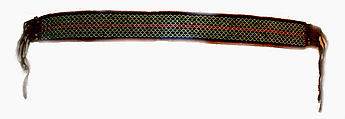Belt (Umutsha)
Not on view
Beadwork, a form of adornment used throughout Africa, plays a central role among the various cultures of southern Africa. As trade with Europe increased, imported glass beads replaced those made of ostrich shells and became a common component of personal decoration. While beadworking has remained the exclusive domain of women, lavishly beaded items created for men and women of all ages often conveyed key aspects of the wearer's identity and social status.
Beaded belts known as umutsha were worn by both Zulu men and women. This example features finely interlocked patterns of glass beads arranged in colorful chevrons on a leather backing. The Zulu, like other Southern African peoples, drew upon distinct colors and color combinations as part of a complex symbolic system, the precise language of which has not been documented. Moreover, the messages woven into such beaded items were of a highly personal nature and thus often only fully understood by those close to the maker. In some cases, however, the overarching significance of specific colors is evident through the name that is given to them. For example, ruby-colored glass beads are known as inkankane, which means "whenever I see you my heart leaps up in little flames."
Due to rights restrictions, this image cannot be enlarged, viewed at full screen, or downloaded.

